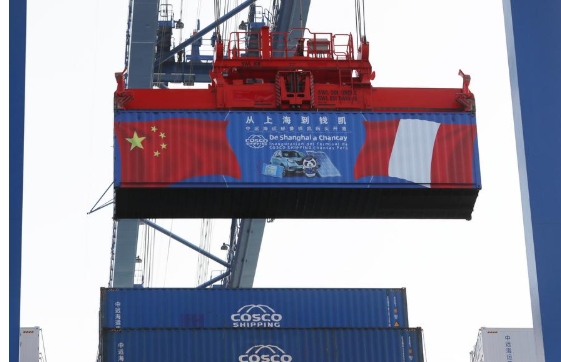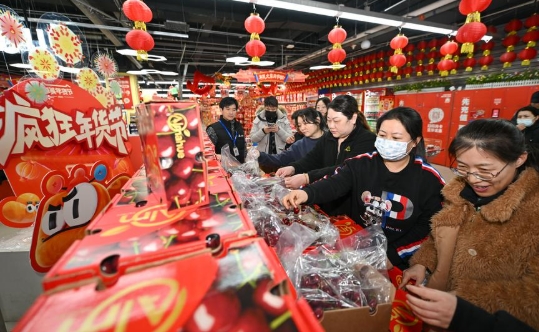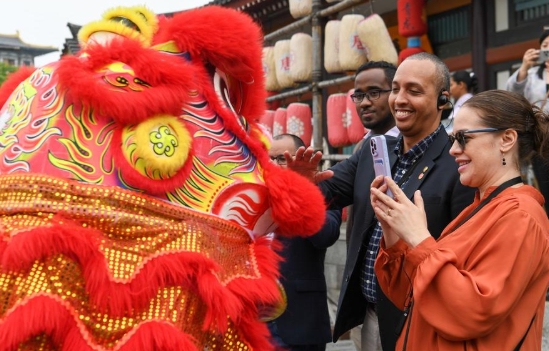How a key mechanism drives China-Latin America cooperation

A container is lifted at Chancay Port in Peru, on Nov. 14, 2024. (Xinhua/Li Mengxin)
Over the past decade, China and its Latin American and Caribbean (LAC) partners have achieved notable progress in building mutual political trust, bolstering economic cooperation, boosting cultural exchanges, and better coordinating international affairs within the framework of the forum's mechanism.
This year marks the 10th anniversary of the launch of the China-Community of Latin American and Caribbean States (CELAC) Forum.
"The China-CELAC Forum, a young seedling in our eyes, needs the dedication and cultivation of both sides for it to grow bigger and stronger," said Chinese President Xi Jinping back in 2015 at the first ministerial meeting of the China-CELAC Forum.
Over the past decade, China and its Latin American and Caribbean (LAC) partners have achieved notable progress in building mutual political trust, bolstering economic cooperation, boosting cultural exchanges, and better coordinating international affairs within the framework of the forum's mechanism.
STRONGER POLITICAL TRUST
The forum has played an important role for China and Latin American and Caribbean (LAC) countries to compare notes in improving governance and aligning their respective development strategies in the past ten years.
Since 2015, three ministerial meetings have been held, as well as eight rounds of dialogue between the foreign ministers of China and the CELAC Quartet, which is composed of the group's previous, current and incoming Pro Tempore Presidency (PPT) and that of the Caribbean Community.
In addition, 43 thematic sub-forums have been established covering key areas such as agriculture, scientific and technological innovation, poverty alleviation, green development, disaster management, defense cooperation, exchanges between think tanks, and anti-corruption law enforcement.
In their in-depth exchanges, the two sides have also explored the path of modernization that suits their respective national conditions.
A series of activities have intensified and expanded exchanges and dialogue between China and LAC, including the IV China-CELAC Political Parties Forum, which gathered representatives of nearly 100 national and regional political parties from 30 LAC countries.
The China-CELAC Forum has evolved in a decade from a vision to a mechanism for practical cooperation, said Sun Yanfeng, a researcher at the Institute of Latin American Studies, under the aegis of the China Institute of Contemporary International Relations (CICIR).

Customers select newly arrived Chilean cherries at a supermarket in Tianjin, north China, Dec. 26, 2024. (Xinhua/Sun Fanyue)
FLOURISHING ECONOMIC COOPERATION
Since December last year, ships loaded with Chilean cherries have sailed across the Pacific to Chinese ports in Guangzhou, Shanghai and Tianjin. As the Lunar New Year holiday arrives, Chinese consumers can enjoy these sweet and juicy cherries at the happy moment of family reunion.
Chilean exports exceeded 100 billion U.S. dollars in 2024, with a 51.4-percent increase in cherry shipments, whose main destination is China, according to the Central Bank of Chile. Other agricultural products from the region, such as Ecuadorian bananas, Nicaraguan honey and Honduran white shrimp, also enjoy growing popularity in the Chinese market.
China is Latin America and the Caribbean's second-largest trading partner and the largest trading partner for countries such as Chile, Brazil and Peru. Five countries in the region have a free trade agreement (FTA) with China. In addition, 2024 saw significant progress, such as the fifth round of negotiations towards a China-Honduras FTA and the upgrading of the China-Peru FTA.
A decade ago, China set the goal for bilateral trade between China and LAC countries to reach 500 billion dollars annually and cumulative investment to hit 250 billion dollars in the LAC region in 10 years.
According to official data, between January and September 2024, bilateral trade reached 427.4 billion dollars, with a year-on-year increase of 7.7 percent, and is expected to exceed the annual target. Chinese direct investment in the region reached 600.8 billion dollars in 2023, consolidating LAC as the second-largest destination for investment from China.
The Belt and Road Initiative (BRI) has become a key platform for both sides to promote trade and economic cooperation. So far, China has signed Belt and Road cooperation documents with 22 LAC countries. Flagship projects jointly built under the BRI, including a four-lane highway in Jamaica, the first smart industrial park in Trinidad and Tobago, and the recently inaugurated Port of Chancay in Peru, have borne fruit.
Brazilian economist Ronnie Lins, director of the China-Brazil Center for Research and Business, said the evolution of LAC-China relations offers more and more opportunities for Latin American and Caribbean countries to achieve economic modernization and promote sustainable development with autonomy.

Members of a delegation of diplomatic envoys, agency representatives and journalists from Latin American and Caribbean countries visit an ancient town in Xiangyang, central China's Hubei Province, April 22, 2024. (Xinhua/Du Zixuan)
DIVERSIFIED CULTURAL EXCHANGES
In the past decade, the China-CELAC Forum has established a comprehensive, multi-level network of dialogue and cooperation that has enriched cultural exchange between China and LAC, strengthening ties between their people.
The China-LAC Year of Cultural Exchange and the "Bridge to the Future" program have promoted unique experiences such as visits by young Latin Americans to Dunhuang to learn about the ancient Silk Road.
Learning the Chinese language and culture has gained popularity in the region, with 57 Confucius Institutes and Classrooms established in 26 countries. Cultural exchanges, such as cultural relic exhibitions on ancient civilizations in China and Mexico, have promoted mutual understanding.
The opening of direct air routes between China and Brazil, Mexico and Cuba has facilitated tourism and trade exchanges, and boosted their commercial ties and tourism exchanges.
Experts and academics believe the China-CELAC Forum will continue to strengthen mutual understanding, expand mutually beneficial cooperation, and advance sustainable development.
Daniel Grimaldi, executive director of Chile 21, said that through open dialogue and mutual respect, China and Latin America can continue to build bridges that strengthen their relations and promote green development and shared modernization.
Luis Antonio Paulino, director of the Confucius Institute at Sao Paulo State University, said China-LAC relations have made impressive progress over the past decades, but there is still great potential to be tapped in the future.
Through joint efforts, China and Latin America can build a closer partnership while making a greater contribution to global prosperity and stability, he added.
Editor:伏娅敏
